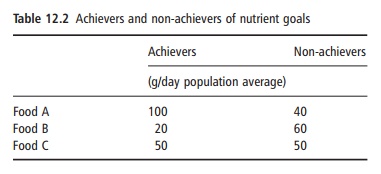Chapter: Introduction to Human Nutrition: Food and Nutrition: Policy and Regulatory Issues
Exploration of dietary patterns
Exploration of dietary patterns
With a given set of population nutrient intake data and a given
set of nutritional reference values, it is possible to divide the population
into those closest to some nutritional ideal and those furthest from such an
achievement.
Based on these comparisons and using appropriate statistical
techniques, it is possible to begin to discern the reasons why one group are
near achieving some nutritional ideal and why another are set far off the mark.
These reasons now feed into policy advice and begin to form the nucleus of a
nutrition regulatory structure that may help the population improve their diet.
Given that the focus of this text is nutrition, it would be worthwhile to single
out food patterns for a more critical analysis. The following is a
hypotheti-cal finding in relation to three foods that appear to be important in
determining the nutritional adequacy of “achievers” and “non-achievers” of some
nutrient goal.
Look at Table 12.2. At first glance C seems unim-portant and A
and B seem to be important and going in opposite directions. These are very
typical data that emerge from such analyses and they hide two very important
statistics that should always be sought in studies of this nature. The first
missing statistic is “% consumers” and the second is the “intake among


Now everything has changed with the five consum-ers converting
population average intakes into con-sumer-only intakes. For any program in
public health nutrition, three important strategies which are often lost are
(a) strategies to increase or decrease the five people eating a target food,
(b) strategies to alter the frequency with which a target food is consumed, and
(c) the portion size when the food is eaten. Thus were we to look solely at
population averages, food C was of no interest. Now it is of interest if not
intriguing: “achievers” universally eat this food while only 30% of
“non-achievers” partake of it, and, among the small group of “non-achievers”
who do eat the food, they eat it at a much higher level (which might be the
same amount more frequently or a higher amount less frequently).
Related Topics